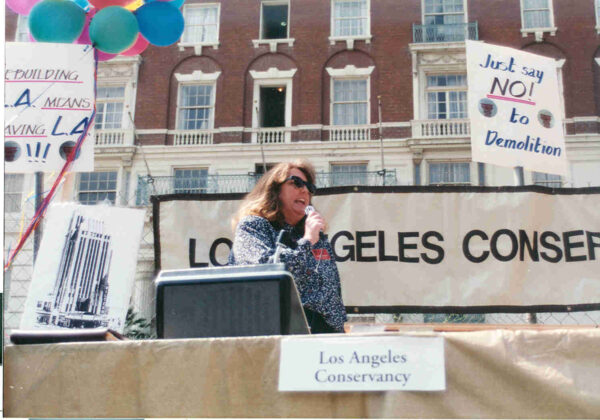
Blog
Linda Dishman: Celebrating 30 Years of Leadership
By L.A. Conservancy Staff
This interview was conducted in 2021 by the L.A. Conservancy’s Director of Communications Lisett Chavarela.
Happy 30th anniversary to Linda Dishman, the Conservancy’s president and CEO! Focused and fearless, Linda has been a force of leadership for the Conservancy and the historic preservation movement throughout California.
Linda joined the Conservancy as executive director in March 1992. Since then, the organization has grown to 5,000 members—the largest membership of a local historic preservation organization in the country—and our budget is now $3 million.
From all of us at the Conservancy, a heartfelt congratulations and thank you!
To celebrate the occasion, we asked Linda to reflect on her time at the Conservancy.
What do you love about working at the Conservancy?
It’s the people! I have a poster on my wall that says, “People make history, people preserve it.” That really encapsulates why our work is so meaningful. We save historic buildings because they mean something to people.
The best part is when I talk to people and they [talk about] a building that has meaning to them. Sometimes it is a school they went to, a little neighborhood store they visited every Saturday with their grandmother, or the house where they grew up that holds their memories. And, sometimes we hear stories about buildings that we all know and celebrate, like City Hall and the Central Library.
We respect that people’s stories reside in many places throughout Los Angeles. They’re what makes Los Angeles so special!
How has preservation changed in the last thirty years?
There is greater public awareness and appreciation for historic buildings and what they do for communities. We can point to many examples that showcase the value of historic preservation on a project. Take the Tower Theatre, for example. It was vacant for over thirty years. Then, Apple came in with a strong vision to adaptively reuse the space in a way that celebrated its historic character on par with its cutting-edge technology.
How has the Conservancy changed since you started?
The Conservancy has more members and staff, more experience, and more great work under our belt! We’re doing more to celebrate the full story of Los Angeles, including nominations of culturally significant sites, community outreach, and a wildly successful legacy business campaign. I’m excited for us to expand this work further. The Conservancy also has more tools and has developed best practices we’re now sharing with the public through our Community Leadership Boot Camps. Win or lose, there is much to be learned from every advocacy effort.
Our work to specifically tell a broader, more inclusive story through our advocacy and educational work has grown the perception of what’s worth saving in truly meaningful ways.
How has the Conservancy stayed the same?
We remain rooted in our values to find win-win preservation-minded solutions. When we’re working on advocacy issues, we focus on options that preserve the historic building and also meet the project’s end goals, whether it is adding housing units or turning a commercial building into office space. The Conservancy is eager to demonstrate how historic preservation can be a tool in helping Los Angeles address critical issues, like housing or climate change.
What was one of your greatest losses at the Conservancy?
It’s really tough to lose a building, especially a building you’ve worked a long time to try and save. That was certainly the situation with the demolition of the Ambassador Hotel in 2005 and 2006. We were sad. I was sad. We did everything possible to provide an alternative to demolition. We’d never had the capacity to do that before. We exhausted every resource and idea. By the time we lost, we lost. But we looked at the effort and thought: how do we use this loss as we look to the future? We learned a lot.
It’s interesting, people still tell me how sad they are about the loss of the Ambassador—even those who were not that supportive at the time.
What is one of your most memorable moments in a historic building?
In talking about the Ambassador Hotel, it brings back the memory of being in the pantry where Robert Kennedy was assassinated.
It was a place of great sadness and being there in person was very powerful. It really resonated as a sacred place. What happened in that pantry changed the direction of our country. The Conservancy wanted the pantry to be preserved for that reason, so students could understand the assassination in a broader context, understand the history of our nation, and be inspired.
What is something people may not know about you?
People think I’m from Los Angeles, but I actually grew up in Sacramento. My mother was from South Pasadena, so I was raised hearing stories of her going to the Broadway theatres, riding the streetcars downtown, and ice cream sundaes at Chatam’s in Westwood Village. She went to UCLA. Even before I came to L.A., I had a strong sense of the history of Los Angeles.
One of my most precious memories is when I was five and came down to Los Angeles with my mom. My grandmother took me to the Ambassador Hotel and we had lunch at the patio there. Maybe that’s why it was poignant when we lost the building.
What is one of your favorite preservation moments?
The evening when the Downey McDonald’s reopened. Saving the Downey McDonald’s was a really hard fight because we were up against one of the biggest corporations in America, who for a variety of reasons didn’t want this building to survive. Thankfully, they changed their trajectory and decided to restore the building. At the opening event, there was a big black-tie affair in the parking lot. The servers came out with platters covered by silver domes for each person. When they opened the silver dome, there was a Quarter Pounder with fries. It was the perfect way to celebrate McDonald’s reopening!





